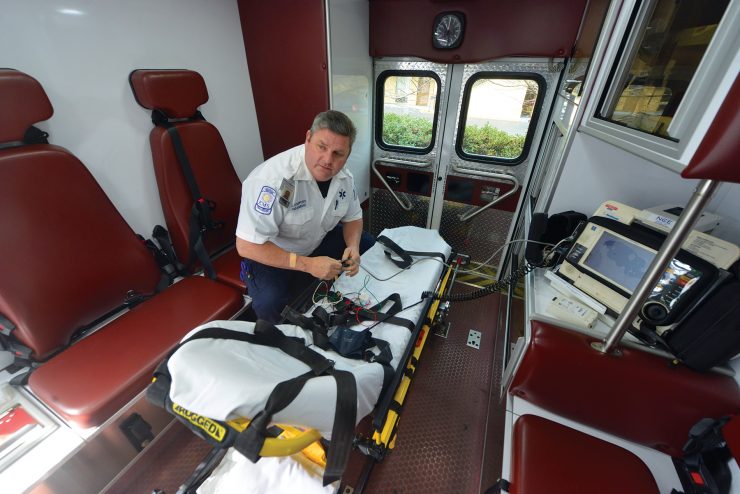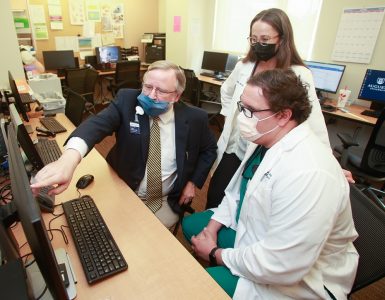Cardiology Team Tackles Toughest Blockages
Genetics helped turn Jody Stafford’s circumflex artery rock hard.
His 47-year-old body was sending subtle hints that something was amiss, but Stafford attributed them to getting older. Until one Saturday morning last June.
The Savannah, Georgia, paramedic had worked all day, then through the night. He got off at 7 a.m. and was at the gym within a half hour. The sluggishness he often felt seemed to vanish that morning as he completed his two-hour routine of riding a stationary bike, lifting weights, then hitting the elliptical. He drove the familiar two miles home to get ready for church, and as he put his truck in park, he felt like he – or maybe a mule – had pulled his chest muscle.
STEMI: STAT!
“I could have gotten a marker and drawn a line around it,” he says of the pain. The paramedic in his head was saying: heart attack. His father had a massive attack at 49, followed by multiple bypasses. He lost weight and died at age 78 of an unrelated problem. Still, the legacy was enough to prompt his son to become a gym rat at age 12. “I found out the hard way, you can’t fight genetics,” Stafford says.
He would end up on his floor twice that morning before conceding to the paramedic in his head. He also became nauseated. “At that point, I knew what it was.” He and his now-fiancee, Brandy Griner, also a paramedic, headed to St. Joseph’s/Candler Health System.
The normally calm man generated more than a few heart palpitations upon arrival in the emergency room, where he diagnosed his own “STEMI,” or ST segment elevation myocardial infarction, which meant he was at immediate risk of death or disability. Stafford’s EKG looked normal, but as more lab results trickled in, he started sweating profusely. The STEMI started showing its colors as Griner lost hers. The cardiology team, led by Dr. William B. Hartley, had Stafford in the catheterization lab within five minutes, where they re-opened and placed a stent in his left anterior descending artery, commonly called the widow maker. It was 90 percent blocked.
Shuttered Passageway
Thanks to the swift response, Stafford appeared to sustain no permanent damage, but there was more to his story and his heart disease. The Savannah team also found the solid rock wall that formed over time in Stafford’s circumflex artery, which helps supply blood to the receiving and pumping chambers of the heart. While happy to be alive, Stafford still felt sluggish, even experiencing some chest pain. His internist, Dr. Rani Reddy of Statesboro, Georgia, called Dr. Deepak Kapoor.
Kapoor, an MCG interventional cardiologist, likens what happened to Stafford’s circumflex artery to the buildup in the drain pipes of an older house. The constant movement of water helps keep the pipes open, but minerals such as calcium and iron tend to drop out of the water, slowly depositing over time. Eventually, the passageway closes and the buildup hardens. In the case of blood vessels, add cholesterol, lipids, a genetic predisposition, and the myriad poisons in tobacco to the list of depositors and, as with the old house, age is a definite factor. By the time deposits have been around for at least three months, the condition – called chronic total occlusion – can make both a CTO and a blocked water pipe feel rock solid.
Collateral Circulation
While a major blockage of his widow maker definitely could have killed Stafford, the total blockage sounds as though it already should have. If it happened quickly, such as with a partially blocked artery becoming abruptly occluded by a blood clot, it likely would have.
“But our body is our friend; it tries to help us,” says Kapoor, Director of the Cardiac Catheterization Laboratory at GRHealth. “Most of these blockages are slowly progressing, giving time for collateral circulation to develop, so you are less likely to be killed suddenly; you get compromised.” Stafford describes the collateral circulation as hands around his heart.
Everybody has some collateral circulation, and while physically active individuals such as Stafford tend to have more, it cannot totally compensate for normal blood volume. “Collateral circulation is there to keep bare-minimum circulation,” Kapoor says. Over time, chronically low blood volume may weaken or even shrink the heart. Kapoor tells patients that while they may never have a heart attack, this kind of damage is likely.
He and a growing number of interventional cardiologists also now tell many of them that they may be able to help.
“Suppose we have you on all the medication we can possibly have you on and you have a 100 percent blockage, and every time you go to the grocery store, you get chest pain and need to stop,” says Dr. Paul B. Poommipanit, MCG interventional cardiologist. “When you are done shopping, you need to stop again because you are getting chest pain. Carrying groceries to your car, it happens again.” The effect can be physically and emotionally draining, often causing anger, depression, and the nagging concern that a heart attack is imminent.
Widow Makers
CTOs are fairly common. Recent North American reports indicate they are found in up to 31 percent of patients with coronary artery disease and in even higher percentages in patients who have had coronary bypass surgery. In fact, CTOs are the main reason patients are referred for coronary bypass surgery, yet patients with total blockage of a single vessel are often not considered a bypass candidate, particularly if they have other health problems such as diabetes, high cholesterol, or hypertension.
The single-vessel exception tends to be that widow maker. For this major heart vessel, surgeons often use a nearby artery from the chest wall for the bypass. Currently, saphenous veins, which are less accustomed to the high pressure inside coronary arteries, are used to bypass other arteries, so their long-term ability to remain open is less certain. In fact, that’s likely why CTOs are even more common in bypass grafts than the original artery.
Interventional cardiologists’ early treatment efforts included sometimes treating a less-diseased donor artery, a nearby coronary artery that had literally reached out to its struggling neighbor to provide the collateral circulation needed to survive, but not thrive. Others just got medication.
Odds in Patients ’ Favor
“Some people will do just fine with their CTOs because they have well-developed collaterals and they continue to remain active and do everything they want to do. Others won’t,” says Dr. Vishal Arora, MCG interventional cardiologist. “So some patients were being undertreated, or we were over-utilizing bypass surgery, which is an option of last resort.”
Interventionalists were initially hesitant to directly apply the intravascular techniques that defined their field when German cardiologist Dr. Andreas Gruentzig performed the first angioplasty on a human in Switzerland in 1977. In the last handful of years, better technology, including taper-tipped guide wires designed to make the first dent in these solid masses, has enabled percutaneous coronary intervention for some CTO patients.
“There is strong evidence that you prolong and improve people’s lives and decrease their risk of future heart attacks by opening a completely blocked artery,” Kapoor says. Early this year, a study at Seoul’s Sungkyunkwan University School of Medicine comparing mortality rates as well as incidence of major adverse cardiac events, such as a heart attack, indicated that patients with a CTO and wellestablished collateral circulation still fared better long term with surgery or percutaneous coronary intervention rather than just medication. “Your goal is to put the odds in their favor,” says Poommipanit.
“The majority who benefit from the procedure are young patients with a weak heart or low heart function who have a large amount of heart muscle in jeopardy,” Arora says. Still, each patient case is heavily vetted for potential benefit versus risk.
Careful Selection
In fact, the risks of doing what they do and doing nothing often are essentially the same: stroke, heart attack, death, the need for emergency bypass surgery. But by careful patient selection, which includes extensive visualization of a patient’s disease, the physicians minimize risk with the goal of improving how well and how long patients live. It’s a sort of mantra echoed by each interventional team member.
After an angiogram scopes out the blockage with X-rays and contrast medium, including any cracks or crevices that might provide an easier point of access, intravascular ultrasound provides additional insight into what the blockage and the artery look like. Even the sound energy bouncing in all directions helps determine whether the CTO is significant enough to fix and aids selection of the optimal stent(s), Arora says. “We use it a lot here,” Poommipanit adds.
The MCG physicians believe the additional views improve outcomes, often by enabling the use of larger stents that ideally help restore predisease levels of blood flow. “Hopefully, that prevents you from coming back to the cath lab soon,” Poommipanit says. Part of the extensive evaluation also includes ensuring the viability of heart muscle that is being underfed by the blocked vessel.
Painstaking Efforts
Typically, intervention comes in a second procedure. In a process that can take hours, as opposed to minutes with a smaller-percentage blockage, the wire is painstakingly inserted first to ensure the correct path to the blockage. Next, the blockage is drilled or lasered away. The cardiologists tailor-make treatments, sometimes entering head on, sometimes just under the innermost layer of the blood vessel to work their way around to the back of an unusually obstinate blockage, or snaking up through the collateral circulation to get to the other end. “It’s usually a little bit softer on the other side,” Poommipanit says of this retrograde approach used in about 30 percent of cases.
“You can stay within the vessel, which is where you want to be, [or] you can go within the walls, as long as you can get back to the lumen,” Arora says. Being too aggressive can result in “exiting” or perforating the artery and causing leakage. Interestingly, some arteries will close right up; sometimes, physicians use a balloon to encourage the closure; rarely, they call in heart surgeons.
When there’s a heavy calcium concentration, as is often the case, they typically use the diamond-dust coated drill bit, whirling up to 180,000 revolutions per minute inside the confines of a fragile, pulsing artery. More X-rays and ultrasound help them stay the course. Negligible debris is generated: the drill generates microparticles about the size of red blood cells that can readily clear, and the laser evaporates the blockage into water and oxygen.
Clearing the Path
Coronary arteries are just a few inches long, and two-thirds of their length can be completely blocked. Once a clear path is reestablished, up to three stents – known as a full metal jacket – are inserted in about 95 percent of patients to help secure the area. Stents today come in a variety of lengths, up to 1.5 inches. They have stronger but thinner walls and better radial strength than previous versions. Most emit a drug that helps reduce scarring as the stent settles into the blood vessel.
The MCG physicians will take on up to two CTOs in a single patient. Most patients require overnight hospitalization and at least a one-year regimen of baby aspirin and Plavix to reduce the risk of blood clots.
Stafford, a self-declared handyman, could hear the faint, familiar sound of the drill Kapoor was using. “I have run a drill all my life. There is nothing I can’t fix with hand tools,” Stafford says with a characteristic grin. But he just couldn’t help thinking about the times the drill got away from him now that he was the one in need of repair.
It turns out Kapoor was pretty handy with the drill as well. These days find Stafford feeling great and back at the gym, hammering away the weight he gained after his heart attack and piling back on the muscle.
Facts:
In addition to using a percutaneous approach to open the circumflex artery, MCG interventional cardiologists use it to open CTOs in the subclavian arteries, which supply the back of the brain and neck, the arms, and chest wall with blood as well as the mesenteric artery, which supplies the gut.
A multicenter U.S. study looking at 1,361 CTO patients from 2006-11 showed an 85.5 percent technical and 84.2 percent procedural success rate, with a 1.8 percent complication rate. In Japan, where the percutaneous approach was developed, similar rates were reported even when the retrograde approach was used. The retrograde approach, used when approaching the chronic blockage from the direction in which blood flows did not work, was used in about 34 percent of the procedures in the U.S. study.
Today, the percutaneous approach is attempted in fewer than 15 percent of CTO cases in North America, and only 7 percent are successfully revascularized, according to an update on developments in the field published last year in the journal Interventional Cardiology. Improved technology in experienced hands has increased success rates. It’s like driving on a mountain road, says Dr. Deepak Kapoor. Those who live there grow accustomed to the experience.









